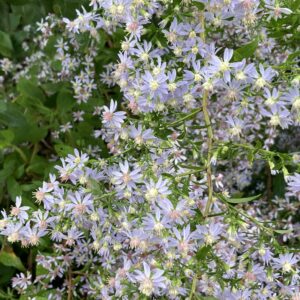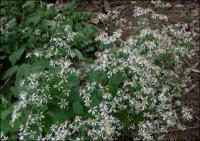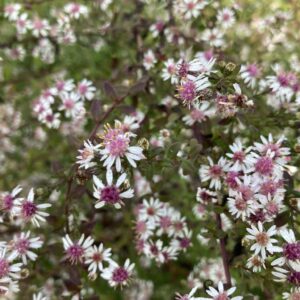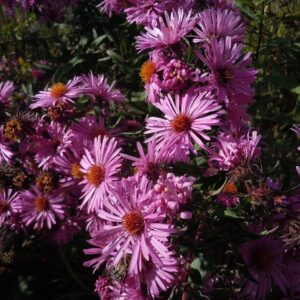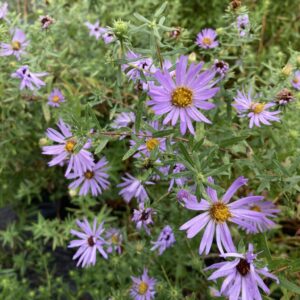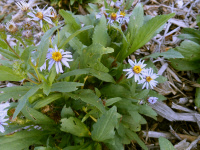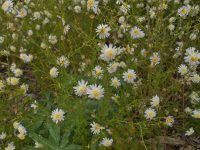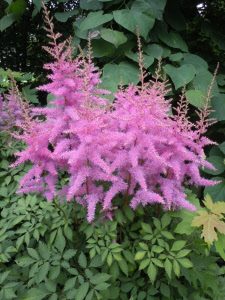Shop
Showing 97–104 of 778 results
-
Aster cordifolius syn. Symphyotrichum cordifolium Blue wood aster Z 3-8
Heart-shaped foliage smothered with blue daisies from late summer into fall, perfect companion for anemones.
Heart-shaped foliage smothered with blue daisies from late summer into fall, perfect companion for anemones.
Size: 2-3' x 2-3'
Care: Sun to full shade in moist well-drained to dry soil
Native: Canada to Florida, west to Oklahoma, Wisconsin native
Wildlife Value: Aster species are nectar sources for many butterflies – Checkered white and Checkered skippers, Spring azure, Pearl crescent, Buckeye, Painted lady, Fiery skipper, Sachem, Sleepy orange, Silver-spotted skipper and Monarch.Winnebago used this in the sweat bath. 1st described by Jacques Philippe Cornut in 1635. Likely collected and transported to France by Samuel de Champlain (1567-1635.) founder of Quebec who traveled from France to “New France” at least 21 times. Grown in Jardin du Roi in Paris.
-
Aster divaricatus syn. Eurybia divaricatus White wood aster Z 4-8
Loose white flower clusters from August to October
Loose white flower clusters from August to October
Size: 12" x 12" and spreading
Care: part shade to shade in moist well-drained to dry soil.
Native: East No. America Quebec to Alabama and west to Ohio
Wildlife Value: Aster species are nectar sources for many butterflies – Checkered white and Checkered skippers, Spring azure, Pearl crescent, Buckeye, Painted lady, Fiery skipper, Sachem, Sleepy orange, Silver-spotted skipper and Monarch.
Awards: Recipient Great Plant Pick Award from Elizabeth Carey Miller Botanical Garden.Sold in America’s 1st plant catalog, Bartram’s Broadside, 1783. Gertrude Jekyll, mother of the perennial border, often used Aster divaricatus in combination with Bergenia. Collected by John Bartram before 1776.
-
Aster laterifolius ‘Horizontalis’ syn Symphyotrichum laterifolius ‘Horizontalis’ Horizontal Calico Aster Z 4-8
Unique horizontally branching aster covered in small pink and white daisy-like flowers with dark pink centers blooming in late summer-fall. Foliage turns copper/purple in fall.
OUT OF STOCK
Unique horizontally branching aster covered in small pink and white daisy-like flowers with dark pink centers blooming in late summer-fall. Foliage turns copper/purple in fall.
Size: 24” x 24”
Care: full sun to part shade in well-drained soil
Native: Eastern and Central North America
Wildlife Value: attracts bees and butterflies. Deer resistant, Black walnut resistant.
Awards: RHS Award of Garden MeritFirst described by French botanist René Desfontaines (1750-1802). Harvard botanist Asa Gray named the variety in 1895.
-
Aster novae angliae syn. Symphyotrichum New England Aster Z 4-8
August – October, classic violet, pink or magenta daisies
August – October, classic violet, pink or magenta daisies
Size: 3-4' x 24"
Care: Full sun dry to moist soil. Heat and drought tolerant.
Native: Vt to Alabama, west to N. M., Wisconsin native
Wildlife Value: Nectar source for many butterflies - Checkered white and Checkered skippers, Spring azure, Pearl crescent, Buckeye, Painted lady, Fiery skip butterfly, Sachem, Sleepy orange, Silver-spotted skipper and Monarch. Host for caterpillars Wavy-lined emerald moth.Aster means star, referring to the flower’s form. For the Cherokee New England aster tea cured fevers and diarrhea. Roots remedied pain and inflammation of the nose and throat. Introduced to garden cultivation by John Tradescant the Younger (1608-1662) in 1637 when he sent it to England where upon borders of New England aster became common. Washington grew New England Aster at Mount Vernon.
-
Aster oblongifolius syn. Symphyotrichum oblongifolium, Aromatic aster Z 3-8
Purplish blue daisies with yellow center blooming in September to November. Good, bushy mound shape.
Purplish blue daisies with yellow center blooming in September to November. Good, bushy mound shape.
Size: 1-2’ x 1-3’
Care: sun to shade in well-drained to moist well-drained soil
Native: Pennsylvania to No. Carolina west to Wyoming & Texas, Wisconsin native
Wildlife Value: Bees collect pollen and nectar from it. Medium sized butterflies collect its nectar. Its leaves support Silvery checkerspot and some moth caterpillars, Deer resistant.
Size: Navajo made a decoction of this to protect against witches.Meriwether Lewis collected this on the Expedition September 21, 1804, the day after nearly being swept away while Lewis and the Corps of discovery slept on the eroding sandbar, near the Big Bend of the Missouri River in South Dakota. 1st described by planthunter Thomas Nuttall in 1818(1786-1879).
.
-
Aster sibiricus syn. Eurybia sibirica Siberian aster, Arctic aster Z 3-9
Lavender daisies from late-summer into fall
ARCHIVED
Note: This is a plant not currently for sale. This is an archive page preserved for informational use.
Lavender daisies from late-summer into fall, valuable for long-blooming and short size
Size: 6-10” x 15-24” Care: sun in well-drained, to moist well-drained, acidic soil
Native: NW US, Alaska, Canada, Arctic & Siberia
Wildlife Value: attracts butterfliesCollected by German plant hunter Johann Gmelin in Siberia before 1753
-
Asteromoea mongolica syn. Aster mongolicus or Kalimeris pinnatafida ‘Hortensis’ Japanese aster, Mongolian aster Z 3-9
Covered with petite double white daisies, blooming for months –late summer-fall
ARCHIVED
Note: This is a plant not currently for sale. This is an archive page preserved for informational use.
Covered with petite double white daisies with golden stamens blooming for months –late summer-fall.
Size: 2-3’ x 1-2’
Care: sun to part shade in well-drained to moist well-drained soil
Native: Japan
Awards: Georgia Gold Medal 1998 Taxonomists had trouble naming this one. First described in French Journal Nouv. Arch. Mus. Hist. Nat. in 1882. A favorite flower of the late garden writer Elizabeth Lawrence who traced it to the grounds of the old Oxford Orphanage in Oxford NC. (1942) -
Astilbe andresii ‘Amethyst’ Z 5-8
pink plumes flowering in July, with oxblood tinged foliage
OUT OF STOCK
Three foot tall pink plumes flowering in July, with oxblood tinged foliage
Size: 36"x 24"
Care: sun to part shade, moist soil essential. Immune walnut toxicity
Wildlife Value: attracts butterfliesAstilbe is Greek from a meaning “without” and stilbe meaning “lustre” referring to the fact that the leaves are not shiny. Early hybrid by George Arends, nurseryman from Ronsdorf, Gemany (1862-1952).

